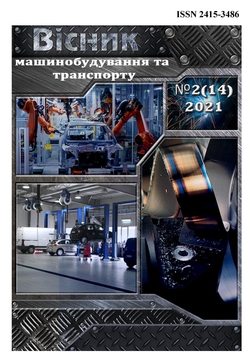Vehicle diagnostic technology
DOI:
https://doi.org/10.31649/2413-4503-2021-14-2-10-17Keywords:
vehicle, technology, mechatronics, diagnostics, research methods, principles of constructionAbstract
In the article, using the example of a mechatronic control system for the engine and transmission of vehicles (automobiles), the features of the technology of their diagnosis are shown. In an electronic transmission control system, the object of regulation is mainly an automatic transmission. Also, the laws of control (programs) of gear shifting in an automatic transmission ensure the optimal transfer of engine energy to the wheels of the vehicle (TC), taking into account the required traction and speed properties and fuel economy. At the same time, the programs for achieving optimal traction-speed properties and minimum fuel consumption differ from each other, since the simultaneous achievement of these goals is not always possible. Therefore, depending on the driving conditions and the desire of the driver, using a special switch, you can select the "economy" program to reduce fuel consumption, the "power" program - to improve traction and speed properties, or the "manual" program to switch gears by the driver. In turn, self-diagnostic capabilities include: system identification and electronic control units (ECU) (ECU); recognition, storage and reading of information about static and single malfunctions; reading current real data, including environmental conditions and specifications; modeling of system functions; programming of system parameters. The individual programs for the test block are stored in the plug-in modules, while the correction and data transfer in the system is carried out via the data interface. Note also that the diagnostic process begins with the initialization of the systems - their detection in the electrical equipment of the vehicle. Upon successful initialization, it is possible to: read the error memory; erase the error memory; view the data of the next detected system or exit to the main menu; change the readings of the selected category; correct the current time; correct the current date and perform a number of additional functions.
References
В. Г. Бутылин, В. Г. Иванов, И. И. Лепешко, А. И. Лещинский, А. А. Юхнов, «Анализ и перспективы развития мехатронных систем управления торможением колеса», Мехатроника. Механика. Автоматика. Электроника. Информатика, № 2, с. 33-38, 2000.
Б. А. Данов, Е. И. Титов, Электронное оборудование иностранных автомобилей: Системы управления трансмиссией, подвеской и тормозной системой. М.: Транспорт, 1998.
Б. А. Данов, Электронные системы управления иностранных автомобилей. М.: Горячая линия – Телеком, 2002.
Х. Сига, С. Мидзутани, Введение в автомобильную электронику. М.: Мир, 1989.
В. П. Волков, И. В. Грицук, Т. В. Волкова, В. П. Кужель, Н. Г. Бережная, «Оценка функциональной стабильности тормозного управления транспортных средств», Вісник машинобудування та транспорту, № 2(12), с. 34-44, 2020. DOI : https://doi.org/10.31649/2415-3486-2020-12-2.
Downloads
-
pdf (Русский)
Downloads: 3500


